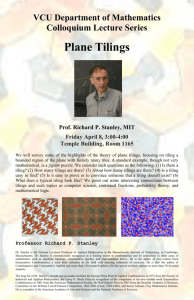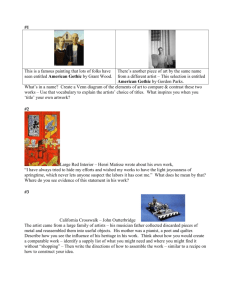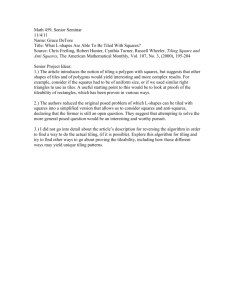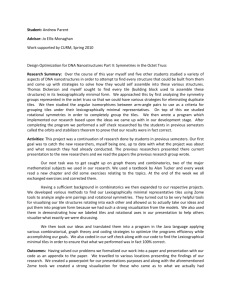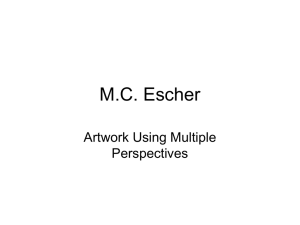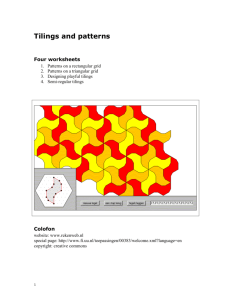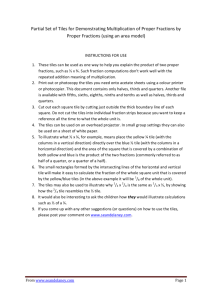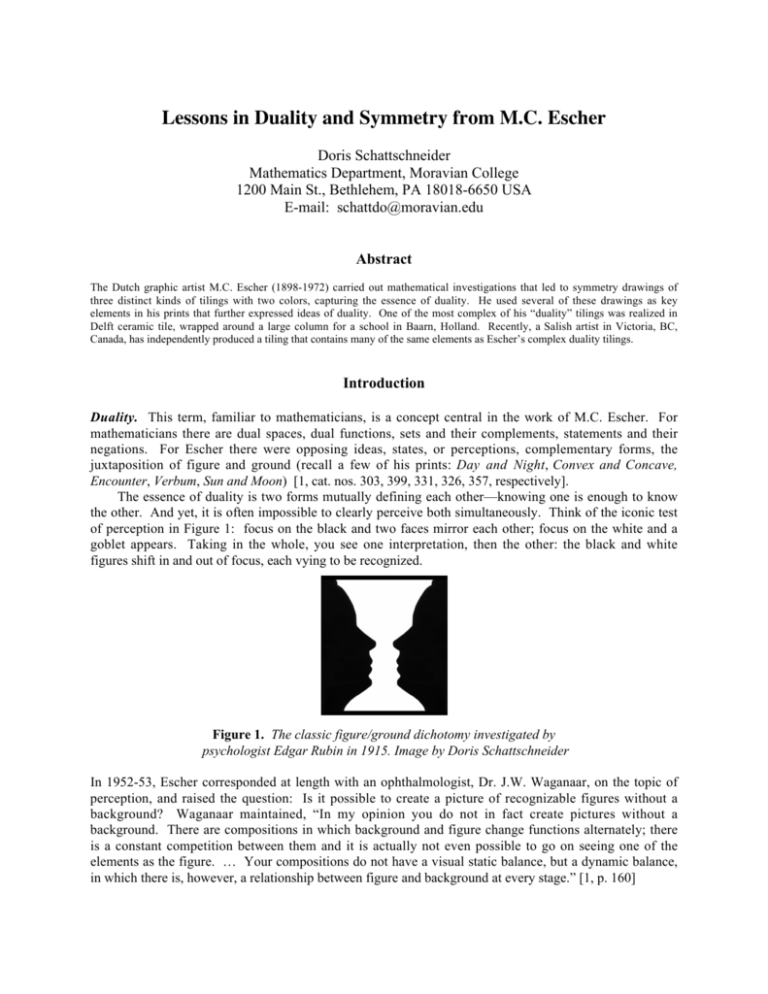
Lessons in Duality and Symmetry from M.C. Escher
Doris Schattschneider
Mathematics Department, Moravian College
1200 Main St., Bethlehem, PA 18018-6650 USA
E-mail: schattdo@moravian.edu
Abstract
The Dutch graphic artist M.C. Escher (1898-1972) carried out mathematical investigations that led to symmetry drawings of
three distinct kinds of tilings with two colors, capturing the essence of duality. He used several of these drawings as key
elements in his prints that further expressed ideas of duality. One of the most complex of his “duality” tilings was realized in
Delft ceramic tile, wrapped around a large column for a school in Baarn, Holland. Recently, a Salish artist in Victoria, BC,
Canada, has independently produced a tiling that contains many of the same elements as Escher’s complex duality tilings.
Introduction
Duality. This term, familiar to mathematicians, is a concept central in the work of M.C. Escher. For
mathematicians there are dual spaces, dual functions, sets and their complements, statements and their
negations. For Escher there were opposing ideas, states, or perceptions, complementary forms, the
juxtaposition of figure and ground (recall a few of his prints: Day and Night, Convex and Concave,
Encounter, Verbum, Sun and Moon) [1, cat. nos. 303, 399, 331, 326, 357, respectively].
The essence of duality is two forms mutually defining each other—knowing one is enough to know
the other. And yet, it is often impossible to clearly perceive both simultaneously. Think of the iconic test
of perception in Figure 1: focus on the black and two faces mirror each other; focus on the white and a
goblet appears. Taking in the whole, you see one interpretation, then the other: the black and white
figures shift in and out of focus, each vying to be recognized.
Figure 1. The classic figure/ground dichotomy investigated by
psychologist Edgar Rubin in 1915. Image by Doris Schattschneider
In 1952-53, Escher corresponded at length with an ophthalmologist, Dr. J.W. Waganaar, on the topic of
perception, and raised the question: Is it possible to create a picture of recognizable figures without a
background? Waganaar maintained, “In my opinion you do not in fact create pictures without a
background. There are compositions in which background and figure change functions alternately; there
is a constant competition between them and it is actually not even possible to go on seeing one of the
elements as the figure. … Your compositions do not have a visual static balance, but a dynamic balance,
in which there is, however, a relationship between figure and background at every stage.” [1, p. 160]
In his essay in which he quotes Waganaar, Escher then tells the reader, “Thus it seems that two units
[tiles] bordering on each other cannot simultaneously function as ‘figure’ in our mind; nevertheless, a
single dividing line determines the shape and character of both units, serving a double function.” He goes
on to admit how difficult it is to create his creature tiles, “After a great deal of patience and deliberation,
and usually a seemingly endless series of failures, a line is
finally drawn [simultaneously delineating the two figures], and
it looks so simple that an outsider cannot imagine how difficult
it was to obtain.” [1, p. 160]
In his hand-done colored drawings of tilings, it is true that
Escher’s adjacent tiles compete to be figure (or ground).
However, in his prints that use fragments of these tilings,
Escher emphasizes both their duality and their individuality by
having the flat shapes that define each other in the tiling
metamorphose into three-dimensional figures, gaining their
independence from each other. His print Sky and Water I in
Figure 2 perfectly illustrates this important aspect of his work.
Figure 2. M.C. Escher. Sky and Water I. Woodcut in black and white. June 1938. 435 × 439.
Symmetry. One definition of symmetry is balance, and this can be interpreted in many ways. Escher was
especially sensitive to symmetry in the composition of many of his prints, balancing foreground and
distant scenes in his early Italian landscapes (e.g., Pines of Calvi, Castrovalva) [1, cat. nos. 230, 132]. He
balanced the placement of figures or even scenes in other prints (e.g., Paradise, Scapegoat, Sky and
Water I and II, Day and Night) [1, cat. nos. 67, 69, 306, 308, 303, respectively].
However, Escher’s greatest obsession was with symmetry as a graceful, regular repetition of forms
that cover the plane. What we today call tessellations or tilings, he called “Regular Divisions of the
Plane,” and he adapted a strict definition that he found in a journal article by F. Haag [4]. For Escher, a
regular division of the plane was a tiling by congruent tiles (he insisted they be recognizable shapes),
with the additional property that every tile be surrounded in the same manner. Today such tilings are
termed isohedral. They are defined by the property that for any chosen pair of tiles in the tiling, there is
an isometry (a translation, rotation, reflection, or glide-reflection) that transforms the first tile in the pair
into the second tile, and at the same time, superimposes every tile in the tiling onto another tile. Such an
isometry is called a symmetry of the tiling. Other ways to express this property is to say the symmetry
group acts transitively on the tiles, or the orbit of one tile under the symmetry group is the whole tiling.
Escher traveled to the Alhambra, in Granada, Spain, in 1922 and again in 1936, and carefully copied
many of the majolica and incised plaster tilings found there. From these, he gleaned what information he
could on their underlying geometry, and employed that knowledge to produce about a dozen original
tilings. But it was his careful study in 1937 of a page of illustrations of tilings in a journal article by the
mathematician George Pólya [5] that set Escher on a four-year intense investigation to determine the
characterizations of shapes of tiles that satisfied the conditions to produce a regular division of the plane.
In 1941-42, at the culmination of his study, he summarized the results of his investigations in two
notebooks. This information enabled him to produce imaginative and complex tilings, governed by the
geometric relationships he had discovered. The keys to his discoveries were the mathematician’s tools of
symmetry—translations, reflections, rotations, and glide-reflections. For many separate cases, he recorded
in terms of these transformations, how a tile was related to each tile that surrounded it. And his
investigations were groundbreaking in what today is called color symmetry: his colorings of tilings were
compatible with the tilings’ symmetries (for details on 2-color symmetries, see [7, 10]). By the end of his
life, he had produced over 150 original tilings, each hand-drawn on squared copybook paper, and then
hand-colored. These drawings were his “storehouses” from which he could select ideas for his prints [9].
Escher’s tilings: duality through two-color symmetry
By a tiling, we mean a covering of the plane by tiles, without gaps, and no overlaps of their interiors. We
use the term vertex for a point at which at least three tiles meet, and edge for a boundary curve of a tile
that connects two consecutive vertices. More than two-thirds of Escher’s tilings use two colors: each tile
is colored in one of the two colors and tiles that share an edge have contrasting colors. This property
(called “map-coloring” by mathematicians) ensures that each tile is surrounded by tiles of the opposite
color, so in the infinite jigsaw puzzle of tiles, each individual tile is recognizable. And of course this
property satisfied Escher’s fascination with duality of figure and ground.
In his notebooks, Escher outlines many cases of tilings in which an even number of tiles meet at each
vertex of the tiling, and hence can be map-colored with two colors. He first enumerates classes of
isohedral tilings in which the congruent tiles have four edges; these tilings require only two colors. He
next shows how a process he called “transition” can produce from a 2-colored isohedral tiling a new
isohedral tiling that requires three colors in order to be map-colored. Later in the notebook, he goes on to
explore ways in which the tiles in these isohedral tilings can be split into two different shapes to produce
new tilings that can be 2-colored.
Escher produced three distinct types of 2-color tilings; each illustrates duality in a different way. In
what follows, we discuss separately each of these types of duality tilings and how he created them.
(1) Two colors, one tile.
More than a third of Escher’s tilings are isohedral (so the tiles are congruent), and the tiling is mapcolored with two contrasting colors. The simplest common example of such a tiling is an infinite
checkerboard, with its familiar red and black square tiles. Escher encountered many such tilings in the
Alhambra with more interesting shapes. One that he copied is shown in Figure 2 with black and white
tiles; he later turned it into a tiling by blue and white butterflies [9, p. 125].
Through the clever use of symmetry, Escher emphasized the dual roles
of the congruent dark and light tiles. In these tilings, the pattern formed
by all tiles of one color (say, white) was exactly the same as that formed
by all tiles of the other color (say, black). One layer is positive, the
other negative, both exactly the same pattern. The Alhambra tiling in
Figure 2 has this property: if the pattern formed by the white tiles was
lifted and rotated 90°, this layer could be superimposed exactly on the
pattern of black tiles. Either layer can serve as figure, the other ground.
Figure 2. A tiling from the Alhambra that Escher transformed into butterflies
But the dual symmetry employed by Escher is even stronger than that. For any chosen pair of tiles in
the tiling, every symmetry of the tiling that sends the first tile in the pair onto the second tile is a color
symmetry. This means that each symmetry of the tiling either preserves all colors or interchanges all
colors: if the two chosen tiles have the same color, then the color symmetry sends every tile onto another
tile of the same color, and if the two chosen tiles have opposite colors, the color symmetry sends every
tile onto another tile of the opposite color. In mathematical terminology, this kind of isohedral tiling is
perfectly colored, and there is at least one symmetry that interchanges colors. In the world of textiles and
art, a tiling or pattern with these properties is sometimes said to have counterchange symmetry.
The Alhambra tiling in Figure 2 is such a tiling. Here 90° rotation symmetries (with centers at the
vertices of tiles) interchange colors, while reflection symmetries (in the vertical and horizontal center
lines of the tiles) and 180° rotation symmetries (with centers at the vertices and at the centers of the tiles)
preserve colors. Vertical and horizontal glide-reflections preserve colors, while diagonal glide-reflections
interchange colors. If all tiles had the same color, the tiling has a p4g symmetry group. With tiles colored
as in Figure 2, the symmetry group of the pattern of tiles of a single color is type cmm; one notation for
the symmetry group of the 2-colored tiling is p4g/cmm. This notation
varies; two sources are [2] and [10].
Escher chose one of his perfectly-colored isohedral tilings as the
cover illustration for his book Grafiek en Tekeningen (Prints and
Drawings), first published in 1959 (Figure 3). The tiles are griffins
(winged cats), and were used in his whimsical print Magic Mirror [1,
cat. no. 338]. In the infinitely extended tiling, all golden cats face left,
outlined by their black mirror-images that face right. Each row of cats
is lined up chin-to-tail, and is defined by a single color. The golden
cats can serve as figure with the black cats as ground, or vice-versa. In
the tiling, all translation symmetries preserve colors, while all (vertical)
glide-reflection symmetries interchange colors.
Figure 3. Escher’s book cover with counterchange symmetry
(2) Two colors, two different tiles, each occurring in a single color.
The duality of the figure/ground illusion of the faces and goblet in Figure 1 is achieved through two
devices: figures of two different shapes share a boundary and these shapes have contrasting colors. In
one-third of Escher’s tilings, two distinct tiles with contrasting colors interlock, with all repetitions of a
single tile the same color. Necessarily, tiles of the same shape touch only at vertices of the tiling; each
tile is completely outlined by tiles of the complementary shape. In addition, these tilings are 2-isohedral,
that is, given any pair of congruent tiles, there is a symmetry of the whole tiling that transforms the first
tile in the pair to the second. Since each shape occurs in only one color, all symmetries preserve colors.
One of Escher’s best-known tilings of this type shows white angels and black devils [9, p. 150]; as a
result, Andreas Dress named such tilings Heaven and Hell tilings [3]. We will refer to them as HH tilings
for short. For an HH tiling, how did Escher manage to get two different motifs (tiles) to perfectly
interlock and then fill the plane with their regular repetitions? He achieved this by beginning with an
isohedral tiling, splitting one tile to produce two separate shapes, then repeating that same split on every
tile in the tiling. In performing the splitting, he had to ensure that the resulting tiling could be mapcolored with two colors in such a way that all tiles of a single shape were the same color [9, pp. 70-76].
Figure 4 recreates the first two cases in his notebook [9, p. 71]
The first case begins with a 2-color tiling in which four tiles meet at every vertex, and edges meet
every vertex in the same way. Here, (Figure 4, left) he splits the tile with a curve that joins opposite
vertices; this produces a new tiling with two distinct tiles in which six tiles meet at every vertex, allowing
the new tiling to be 2-colored. The second case (Figure 4, right) begins with a 3-color tiling in which
three tiles meet at each vertex, and there are two distinct vertex types. In this case, he splits the tile with a
curve that joins opposite vertices of different types; this produces a new tiling with two distinct tiles in
which four tiles meet at each vertex, so it can be 2-colored. While the original tilings have translation
color-changing symmetries, in the HH tilings produced, those same symmetries now preserve all colors.
Figure 4. Splitting each tile in an isohedral tiling can produce a 2-color 2-isohedral HH tiling
Escher investigated splittings of all of the categories of isohedral tilings he had discovered, and
considered variations in the choices of splitting curves for a single tiling. In most cases, the splitting
produced an HH tiling; in some cases, a 2-colored tiling was produced in which each of the two different
tiles occurred in both colors (this is discussed in (3) below). Although the technique may be simple in
theory, it was a painstaking process for Escher to derive the
shape of a tile and its splitting curve so as to produce two
distinct, recognizable, complementary figures.
In most of Escher’s HH tilings, the two tiles have very
different shapes (e.g., angel/devil, fish/frog, fish/boat,
bird/fish, horse/bird). But he produced a few HH tilings in
which the two tiles have very subtle differences, and some
viewers have believed the tiles to be congruent. The geese in
the tiling for the print Day and Night fooled the editor of
Scientific American, who identified the birds as being
identical [6]. In fact, as Escher pointed out, they are two
different shapes—white geese have tails up, blue geese have
tails down. This was Escher’s first HH tiling, and has only
translation symmetries (Figure 5).
Figure 5. Escher’s drawing no. 18. 1938. An HH tiling used in the print “Day and Night.”
(3) Two colors, two different tiles, each occurring in both colors.
As Escher investigated splittings for each of his ten categories of isohedral types of quadrilateral tiles
and several “transitional” tilings derived from them, he found two or even more variations of splitting the
tiles. Each variation produced a different 2-color, 2-motif tiling. Several of these new tilings were
surprisingly complex—they had two distinct shapes of tiles, but each shape repeated in both the dark and
the light color. These tilings, like those discussed in (2), were 2-isohedral, but also had the property of
counterchange symmetry discussed in (1), and were perfectly colored. Although Escher inventoried over
25 of these tilings, he completed only seven numbered colored drawings exhibiting this “double duality.”
His first drawing with “recognizable” tiles, made in 1941, shows graceful interlocked birds and fish
(Figure 6a). Although he designed an inlaid door with this pattern, it was not fabricated. In 1952 he used
the tiling cleverly in his print Two Intersecting Planes [1, cat. no. 377]. The print shows thickened tiles,
each layer (one dark, one light) cut from a slab of wood. The two slabs with fish and bird cut-outs
intersect at a sharp angle, showing how they perfectly fit together, one serving as figure, the other ground.
The tiling in Figure 6a likely began with a 3-color tiling resembling interleaved fish (Figure 6b);
Escher then split each tile into a bird and a fish. Each tile in Figure 6b has six vertices (identified by dots
Figure 6a. Escher’s drawing no. 34B. 1941.
Used in the print “Two Intersecting Planes.”
Figure 6b. The 3-color tiling from which Escher
likely derived the 2-motif, 2-color tiling 34B.
on one tile) and the edges that connect consecutive vertices on this tile are labeled (in cyclic order,
starting at the left) with Heesch notation TG1G2TG2G1. The two edges labeled T are related by a
horizontal translation, while the pair labeled G1 and the pair labeled G2 are related by glide-reflections
(axes of these glide reflections are shown as dotted lines). Escher’s splitting curve joins opposite vertices
of the original tile so that in the new tiling by birds and fish, one glide-reflection interchanges birds in a
column and the other glide-reflection interchanges fish in a column. All glide-reflections interchange
colors while all translations preserve colors.
One of the last tilings produced by Escher was another intricate bird-fish tiling, perfectly colored and
having counterchange symmetry (Figure 7a). Created in 1967, it was based on an underlying square grid,
so curved square tiles could be fabricated by the Delft tile company. The tiles wrapped around a large
column, recreating the creatures’ graceful dance. Escher’s use of symmetry produced economy: only one
mold was needed for the single ceramic square tile containing (in pieces) two birds and two fish. By
glazing the tile in two different states—one with white birds and black fish, the other with colors
interchanged (Figure 7b), the repeating design was produced by alternating positive and negative versions
of the square tiles in horizontal rows, while matching the same-colored tiles vertically (Figure 7c).
b
a
c
Figure 7 a) Escher’s drawing no. 126. 1967. b) Design for Delft tile, to be glazed in two ways.
c) Tiled column in Baarn school.
Although this tiling, like that in Figure 6a, began with an isohedral tiling having glide-reflection
symmetry, the boundary of the original tile and Escher’s manner of splitting it into a bird and a fish
caused significant differences in the two derived 2-isohedral tilings. In Escher’s drawing 34B (Figure
6a), each fish shares two edges with other fish; similarly, adjacent birds also share two edges. But in
drawing 126 (Figure 7a), no fish share any edges, while each bird shares two edges with adjacent birds.
Also, the color symmetries in drawing 126 are different from those in drawing 34B. As you can see in
Figure 7c, there are vertical glide reflections (with axes near the edges of the square tiles) that interchange
colors and other vertical glide-reflections (with axes near the centers of the square tiles) that preserve
colors. In addition, horizontal translations interchange colors while vertical translations preserve colors.
Escher favored glide-reflection symmetry in his tilings, and so it is not surprising that all but one of
his double-duality tilings have glide-reflection symmetry. Those discussed thus far have this symmetry.
His drawing 130 of fish and donkeys [9, p. 223] has exactly the same color symmetries as those of
drawing 126 in Figure 7. Three additional double-duality tilings have two fish motifs (not surprising,
since viewed from above, these creatures can have curvy outlines, and can swim in any direction).
Drawings 57 and 58 (Figure 8) both show tilings by two species of fish, and display new or additional
symmetries. His tiling of two swirling fish in drawing 57 (Figure 8, left) has only rotation and translation
Figure 8. Escher’s drawing nos. 57 (left) and 58 (right). 1942.
symmetries. Here 60° and 180° rotation symmetries interchange colors, while translation and 120°
rotation symmetries preserve colors. In drawing 58 (Figure 8, right), fat and skinny fish glide past each
other in columns, all light fish swimming up, all dark fish swimming down. Here, 180° rotation
symmetries interchange dark and light columns of fish and horizontal glide-reflection symmetries also
interchange colors. Vertical glide-reflections and all translation symmetries preserve colors. Escher used
this design for a commissioned New Year’s greeting card. His third drawing of a double-duality tiling of
two different fish is numbered 41 [9, p. 147], and has the same color symmetries as his drawing 58.
There is one other 2-colored tiling by Escher that might be considered a double-duality tiling, but it
depends on interpretation. In his 2-colored drawing 125 [9, p. 218], if you omit the internal detail of the
tiles, they are all congruent, resembling flying fish, and so the tiling is the type discussed earlier in (1). If
internal detail is taken into account, then there are two different creature tiles, and the tiling is perfectly
colored, with the same color symmetries as drawing 34B in Figure 6a.
Escher inspiration — A new double duality tiling
Escher’s fascination with duality and symmetry is contagious. Although the types of duality tilings
discussed in (1) and (2) are relatively common, double duality tilings discussed in (3) are rare.
Recently I learned of the work of Dylan Thomas, a Coast Salish artist from the Lyackson First
Nation, in British Columbia, Canada. The Salish are known as “The Salmon People,” and for centuries,
fished the rich waters of the Pacific Northwest for salmon. But in the past decades, the number of salmon
has dropped considerably. Thomas’s print Salmon Spirits (Figure 9) represents the overcrowding of
salmon in the spirit world. The print was inspired by Escher’s work in an indirect way.
The artist says that it was Escher’s tiling of butterflies with 6-fold rotation symmetry that inspired
him [9, p. 70]. He decided to look for a way to have 4-fold symmetry with a tiling of salmon, the motifs
done in the style of Salish art. He began with a grid of squares, and guided by the concept of “flow,”
important in their art, developed the edges of the square into sinuous curves. The curvy squares served
two roles: they outlined four salmon rotating about the center point where dorsal fins touched, and they fit
together in a tiling. Thomas also wanted four salmon to be seen rotating about a point where their
pectoral fins touched; in order to fill the curvy square in this manner, he had to change the salmon motif
slightly by joining the pectoral fin to the tail with a deeper curve. He then put together the curvy squares,
each with four salmon, alternating the two types of squares in rows and columns, like a checkerboard.
Just as with Escher’s geese in Figure 5, it is easy to believe (falsely) that the salmon tiles are identical.
Escher discovered three types of 2-isohedral, 2-color tilings with counterchange symmetry by
splitting tiles in a tiling with 4-fold (90°) rotation symmetry. His arrangement of color symmetries in one
of these [9, p. 75, top left] is the same as those in Salmon Spirits, but Thomas’s arrangement of tiles is
quite different from Escher’s. The inset in Figure 9 shows schematically how the tiles and the symmetries
in Salmon Spirits are arranged in an extended tiling. Just as in the print, hollow circles identify eyes of
the salmon. Small solid squares identify 4-fold rotation centers where pectoral fins of identical salmon
meet; the small open square is a 4-fold rotation center where dorsal fins of the other salmon meet. Small
diamonds identify 180° rotation centers for the tiling. The edges of the large superimposed square define
minimal translation vectors for symmetries of the extended tiling; this square encloses 8 salmon, four of
each type (in pieces). Translation symmetries and 180°
rotation symmetries preserve colors, while 90° rotation
symmetries interchange colors.
I think that Escher would have been pleased.
Figure 9. Salmon Spirits. © Dylan Thomas. 2007
Acknowledgement. All M.C. Escher works © The M.C. Escher Company B.V. Baarn, The Netherlands. Used by
permission. All rights reserved. www.mcescher.com
References
[1] F.H. Bool, J.R. Kist, J.L. Locher, and F. Wierda, eds. M.C. Escher: His Life and Complete
Graphic Work . New York: Harry N. Abrams, l982; Abradale Press, 1992.
[2] H.S.M. Coxeter, Coloured Symmetry. In M.C. Escher: Art and Science, H.S.M. Coxeter, M. Emmer,
R. Penrose, and M.L. Teuber, editors, pp. 15–33. Amsterdam: North-Holland, 1986.
[3] A.W.M. Dress, The 37 combinatorial types of “Heaven and Hell” patterns in the Euclidean Plane.
In Coxeter et al, (see [2]) pp. 35–45.
[4] F. Haag, Die regelmässigen Planteilungen und Punktsysteme. Zeitschrift für Kristallographie 58
(1923): 478-488.
[5] G. Pólya, Über die Analogie der Kristallsymmetrie in der Ebene. Zeitschrift für Kristallographie 60
(1924): 278-282.
[6] Scientific American, v. 204, no. 4, April 1961, cover and p. 4.
[7] D. Schattschneider, In Black and White: How to Create Perfectly Colored Symmetric Patterns.
Computers and Mathematics With Applications 12B (1986): 673-695.
[8] D. Schattschneider, The Many Faces of Symmetry in the Work of M.C. Escher. In Symmetry 2000,
ed. I. Hargittai and T.C. Laurent, 173-184. London: Portland Press, 2002.
[9] D. Schattschneider, M.C. Escher: Visions of Symmetry. New York: Harry Abrams, 2004.
[10] D.K. Washburn, and D.W. Crowe. Symmetries of Culture: Theory and Practice of Plane Pattern
Analysis. Seattle: University of Washington Press, l988.

